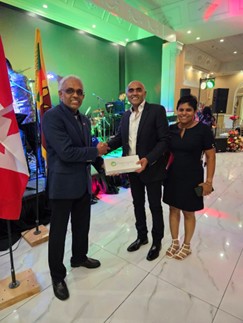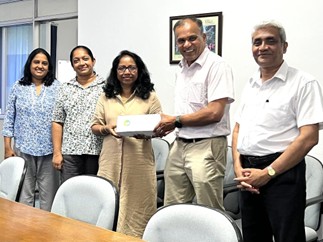Enhancing Research and Teaching at University of Colombo
CUFSAA-NA has recently donated another MultispeQ instrument to the Department of Plant Sciences at the University of Colombo, benefiting both students and faculty members. The CUFSAA extends its gratitude to Dr. Prabode Weebadde, President and Co-Founder of PHOTOSYNQ INC., and Professor Cholani Weebadde of the Department of Plant, Soil and Microbial Sciences at Michigan State University for donating this equipment. This marks the third MultispeQ instrument donated to the Plant Science Department, further strengthening their research and teaching activities.

The official handover ceremony took place at the Dean’s Office of the University of Colombo on Friday, October 10, 2025. CUFSAA member Dr. Arya Jayatilaka presented the instrument during this event. Special thanks are extended to the members who supported this project, as well as to the Weebadde family for their invaluable support to CUFSAA. Additionally, appreciation goes to Dr. Gayani Tillekeratne and Dr. L.M.K. Tillekeratne for delivering the instrument to the University of Colombo in Sri Lanka, and to Dr. Arya Jayatilaka for formally handing it over to Professor Dharshani Bandupriya, Head of the Plant Science Department.

About MultispeQ V2.0
The MultispeQ V2.0 is an innovative, low-cost ($2,499.00) instrument that combines the capabilities of a handheld fluorometer, chlorophyll meter, and bench-top spectrometer. This modifiable tool brings laboratory-quality measurements to field applications, making advanced plant science accessible for teaching and research.
According to Professor Bandupriya, previously donated MultispeQ units by CUFSAA have proven to be extremely valuable for both teaching and research activities. The addition of this third instrument further enhances the department’s capacity for research and education.

The MultispeQ V2.0 enables users to measure photosynthetic phenotypes in real field conditions, identify biotic and abiotic stresses in plants or algae, and collect extensive data worldwide through the collaborative PhotosynQ network. It is designed to be affordable, powerful, modifiable, and collaborative, meeting the needs of modern plant science research and teaching activities.
The instrument can measure a range of fluorescence-based parameters for plants and algae, including ΦII, LEF, NPQ, qE, qI, qL, qP, as well as absorbance-based parameters like vH+, gH+, and ECSt.
Additionally, it records vital abiotic factors such as ambient temperature, relative humidity, barometric pressure, and altitude, along with contactless leaf temperature, leaf angle, and leaf direction. The device automatically adds location and time stamps to all measurements. Its flexible system allows users to create measurement protocols and code for data analysis, and it includes a port for additional sensors (USB 3.0). Data can be easily viewed and analyzed in a browser, with support for advanced analysis using R or Python libraries.
The versatility of the MultispeQ system makes it an invaluable asset for both laboratory and field applications. It is especially beneficial for undergraduate courses across all four levels, as well as for final-year research projects in the Special degree program. Postgraduate students and researchers can also utilize the instrument to study plant responses to various stress conditions, including measurements of chlorophyll content, photosynthetic efficiency, linear electron transfer, non-photochemical quenching, and absorbance-based parameters.
For more information about the features of this instrument, please visit the link below: MultispeQ | PhotosynQ | United States
